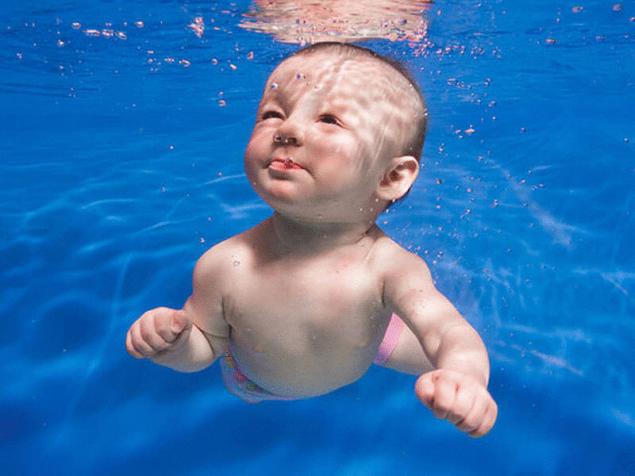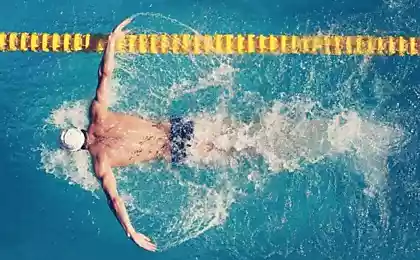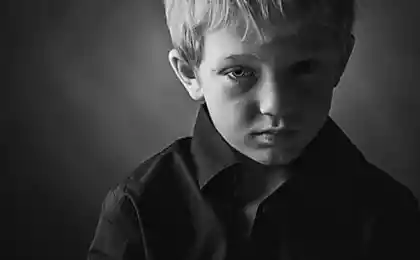260
How to teach a child to swim – useful recommendations
We will talk about children from one year and older. Babies are pretty much the same. But there is a specificity, of course.
What You Should Not Do (Neither in the Bathroom or the Pool)Never blow a child on his face (there are whole books with a technique by which you need to blow a child on his face before immersion) – it frightens the child, hurts him. It has nothing to do with water training.

Never say “Dive” to your child before diving. Don’t give any “standard” commands at all. That is, there should be no repeating before each immersion signal: words, movements. The child should not hold his breath on command. He has to get used to the fact that if he gets into the water at any moment, he can be head in the water. The child should hold his breath when immersed in water, when water hits the face - always. Otherwise, then he will cry if the team does not come, and you want to dip him. You have to dive many times and swim by yourself soon. Of course, not all this catastrophically interferes and sooner or later children get used to holding their breath. But it is better not to teach than to relearn.
Never put your baby in water on your back. This is the most unfortunate position to study. Many instructors recommend it, but almost all children do not like it. It's a defenseless position! It's uncomfortable for the baby! Besides, it's dangerous! It's easier to get water. Learning to swim on your back is a hundred times more difficult than swimming with your back up. All children begin to swim underwater first, and then learn to raise their heads to breathe in. At first, parents help children breathe.
Do not use any additional watercraft - circles, vests, armlets. All this only distances the child from the idea that he can swim. This shows the child that without “propors” he can not be in the water!
Do not teach your child to pinch his nostrils with his fingers. The water will flow into the nostrils just a little bit. And the child from the very beginning, if you do not interfere with him, learn to overcome this slight discomfort and sprinkle water when emerging.
What NOT to do:Do not drive your child through water so that his head is above the water. You know, on every beach, there's always a couple of moms or even daddies who, clutching their baby by the torso, leading him on the surface of the water with the words "come on, work with your feet!" and so on. This gives the child the false impression that he is about to be released and float, sticking his head out. That's not gonna happen! As I wrote above, children begin to swim, lowering their head under water and only then, after a while, begin to emerge for inhalation, and only after that gradually learn to swim, sticking their head out of the water.
Teach your child not to be afraid of waterFor the most fearful, the smallest amount of water.
If a child is afraid of water, then you need to start a friendship with water literally with a small bowl.
Pour water, throw toys, molds, cups and so on. The more the child plays with the water, the better.
If the child agrees to play in the bathroom, put the bowl on the bottom of the bath and put the child there.
If the child does not go into the bath, then let him play on the floor in the kitchen or in the sink in the kitchen. Let him play outside. But do not start with inflatable pools, namely with bowls and basins.
Let's get some more water.If a child is happy to play in the water, let all his water toys and fun move to a small inflatable pool on the street. If you do not have a cottage, go to the beach to the river or the sea (what you have there at hand), throw his toys there and pour at least some water from the river (sea).
Walking on waterIf the child is not so panicky afraid of water, as in previous cases, then do not start with bowls and basins. You should not even put an inflatable pool, it is better to immediately start wetting your legs and playing with water in shallow water. The same - cups, molds, shoulder blades, tubs and so on. Play together! Sit in the water and play – the more, the better.
Put your face in the water.The most important skill that a child needs to learn is to dip his face in water without fear. In fact, as soon as a child puts his face in the water without fear, consider that in a week he will swim. Not style, of course, but flounder under the water already able, overcoming at least a meter or two.
So, we remember that you can not cover your nose (mouth, eyes) with your hands – this applies to adults and, of course, children. The face should be relaxed, there is no need to strain, there is no need to “solemnly” gain a lot of air, there is no need to inflate the cheeks. Everything should be done calmly, easily, with pleasure.
For the most fearful children, washingI propose to start generally with washing, or rather, with dipping the face in water, which is placed in the palms. When washing (or washing a child), stand behind the child, stretch your hands forward, so that they are in front of the child. Put water in your hands and let the baby dip his face into the water, and you with a slight delay wash him. There is little water in your hands and more in yours. But the water in a few seconds will pour out and it is not at all scary - it is only washing!
For the braverDip your face in the water in the bath (or basin). You can just dip, or you can arrange games. For example, dip your face in water and let bubbles (push air out of your mouth) and make funny sounds. You can even try to sing underwater, it’s fun.
Another game is to pull a piece of apple or other convenient object out of the water with your mouth. The apple should be so deep that it is convenient to bite it. In this game, the child not only dips his face into the water, but also learns not to swallow water, but to push it out of his mouth, to block its penetration into his mouth. However, if the child does not want, do not insist. There are no mandatory exercises. There are only different options from which you can choose.
Splashing gamesPerhaps this is the most important trump card! All children love to splash and play with water. Well, maybe not 100%, but the vast majority.
If the baby loves such games in low water (in the bathtub, in the basin, in the inflatable pool), then it will be easier for us to captivate him with water in other “waters”.
clap your hands on the water
Let's clap, slap for fun! In the bath, in the basin, in word or in shallow water on the river (sea), in short, where it got.
Watering with water, scooping it up
Oh, how nice it is to douse your mother or a friend with a glass or something. Arrange such a stormy entertainment in the country!
= Stomping on the water
This is convenient to do in an inflatable pool, in the bath, when there is little water (but it is necessary that the child holds on to either his mother or a reliable support!). In the basin, too, you can, but make sure that, having played out, the child does not fall.
Water for this “exercise” should be almost ankle – no more.
You can stomp in shallow water on the river (sea), but also - be sure to hold the child by the hand.
I kick on the water while sitting.
In the bath or in the pool, let the child sit down, stretch his legs and beat with straight legs on the shallow water - at the very top, raising splashes of water. It's both fun and useful!
= Floating in the water
This is convenient only in an inflatable pool, and even if it stands on grass, and not on a concrete coating. Or in a shallow water on the river (sea), if the bottom is not rocky. .
Stand up and slap our ass! You can even jump in the process of spitting! The water in the pool should be so that the child, sowing, turned out no deeper than under the armpits.
= Falling into the water
It's for particularly divergent... The child stands and falls into the water almost flat – forward.
It is convenient to do in an inflatable pool, if its size allows. Or shallow water on the river (sea).
Water happiness - water park
Nothing encourages a child to enjoy the water like a visit to a water park, especially if it has a good children's area. Not one tiny pool with two pots, but many water activities.
If your child is completely afraid of water, you may need to visit the water park several times.
The main thing is not to sit on a sun lounger! Stay in the water all the time! And in the children's area. Sooner or later your child will join you. But do not drag him by force, by shouting.
Basic rules of water managementStarting classes with a child, you should really assess your strength – can you devote enough time to it? Only regular classes give results. The baby is weaning VERY quickly!
A child should love training! He should enjoy the water! He should not shout like the victim when you bring him into the bathtub, drive up to the river or approach the building of the pool, and start shouting “Hurrah!”. It is this cry that my children announce around the pool or lake.
Nothing should ever be done through crying, through negative emotions. That is, the child may slightly bite or show an unhappy face. And you have to make him laugh, calm him down, distract him.
By bathing a child in warm or hot water, we will let him relax, but we will probably not teach him how to swim. It is advisable to accustom the child to more or less cool water. Early swimmers say it’s best to swim 21-24 degrees. But the vast majority of moms can't do that. They themselves can not be in such water (although in the sea in such water would swim, but sitting in the bath is cold). But still, try to gradually reduce the temperature in which you and your child sit in the bath. Well, at least until 26-28. Water is warmer than 30 degrees – already considered too warm! It is good to relax, not swim.
Not to impose "occupations", but to make water a natural environment, like air. My kids in the pool or at sea don’t “exercise” – it’s part of their lives. Little they slept in the water, ate, played finger games right under the water. In the water should be a lot of songs, games, jokes, poems and other entertainment.
Praise the child a lot in class! Praise the nonsense. Praise not for anything, even if it bursts from a single dip. Especially if he did something worthwhile! In a word, always praise!
Show your child your tenderness and care. Support him in every way possible! Make sure to kiss him when he comes out! At first, of course, because then it will just float away from you. published
P.S. And remember, just changing our consumption – together we change the world!
Source: baby-journal.eu/2015/04/esli-vy-sobralis-uchit-rebenka-plavat/
What You Should Not Do (Neither in the Bathroom or the Pool)Never blow a child on his face (there are whole books with a technique by which you need to blow a child on his face before immersion) – it frightens the child, hurts him. It has nothing to do with water training.

Never say “Dive” to your child before diving. Don’t give any “standard” commands at all. That is, there should be no repeating before each immersion signal: words, movements. The child should not hold his breath on command. He has to get used to the fact that if he gets into the water at any moment, he can be head in the water. The child should hold his breath when immersed in water, when water hits the face - always. Otherwise, then he will cry if the team does not come, and you want to dip him. You have to dive many times and swim by yourself soon. Of course, not all this catastrophically interferes and sooner or later children get used to holding their breath. But it is better not to teach than to relearn.
Never put your baby in water on your back. This is the most unfortunate position to study. Many instructors recommend it, but almost all children do not like it. It's a defenseless position! It's uncomfortable for the baby! Besides, it's dangerous! It's easier to get water. Learning to swim on your back is a hundred times more difficult than swimming with your back up. All children begin to swim underwater first, and then learn to raise their heads to breathe in. At first, parents help children breathe.
Do not use any additional watercraft - circles, vests, armlets. All this only distances the child from the idea that he can swim. This shows the child that without “propors” he can not be in the water!
Do not teach your child to pinch his nostrils with his fingers. The water will flow into the nostrils just a little bit. And the child from the very beginning, if you do not interfere with him, learn to overcome this slight discomfort and sprinkle water when emerging.
What NOT to do:Do not drive your child through water so that his head is above the water. You know, on every beach, there's always a couple of moms or even daddies who, clutching their baby by the torso, leading him on the surface of the water with the words "come on, work with your feet!" and so on. This gives the child the false impression that he is about to be released and float, sticking his head out. That's not gonna happen! As I wrote above, children begin to swim, lowering their head under water and only then, after a while, begin to emerge for inhalation, and only after that gradually learn to swim, sticking their head out of the water.
Teach your child not to be afraid of waterFor the most fearful, the smallest amount of water.
If a child is afraid of water, then you need to start a friendship with water literally with a small bowl.
Pour water, throw toys, molds, cups and so on. The more the child plays with the water, the better.
If the child agrees to play in the bathroom, put the bowl on the bottom of the bath and put the child there.
If the child does not go into the bath, then let him play on the floor in the kitchen or in the sink in the kitchen. Let him play outside. But do not start with inflatable pools, namely with bowls and basins.
Let's get some more water.If a child is happy to play in the water, let all his water toys and fun move to a small inflatable pool on the street. If you do not have a cottage, go to the beach to the river or the sea (what you have there at hand), throw his toys there and pour at least some water from the river (sea).
Walking on waterIf the child is not so panicky afraid of water, as in previous cases, then do not start with bowls and basins. You should not even put an inflatable pool, it is better to immediately start wetting your legs and playing with water in shallow water. The same - cups, molds, shoulder blades, tubs and so on. Play together! Sit in the water and play – the more, the better.
Put your face in the water.The most important skill that a child needs to learn is to dip his face in water without fear. In fact, as soon as a child puts his face in the water without fear, consider that in a week he will swim. Not style, of course, but flounder under the water already able, overcoming at least a meter or two.
So, we remember that you can not cover your nose (mouth, eyes) with your hands – this applies to adults and, of course, children. The face should be relaxed, there is no need to strain, there is no need to “solemnly” gain a lot of air, there is no need to inflate the cheeks. Everything should be done calmly, easily, with pleasure.
For the most fearful children, washingI propose to start generally with washing, or rather, with dipping the face in water, which is placed in the palms. When washing (or washing a child), stand behind the child, stretch your hands forward, so that they are in front of the child. Put water in your hands and let the baby dip his face into the water, and you with a slight delay wash him. There is little water in your hands and more in yours. But the water in a few seconds will pour out and it is not at all scary - it is only washing!
For the braverDip your face in the water in the bath (or basin). You can just dip, or you can arrange games. For example, dip your face in water and let bubbles (push air out of your mouth) and make funny sounds. You can even try to sing underwater, it’s fun.
Another game is to pull a piece of apple or other convenient object out of the water with your mouth. The apple should be so deep that it is convenient to bite it. In this game, the child not only dips his face into the water, but also learns not to swallow water, but to push it out of his mouth, to block its penetration into his mouth. However, if the child does not want, do not insist. There are no mandatory exercises. There are only different options from which you can choose.
Splashing gamesPerhaps this is the most important trump card! All children love to splash and play with water. Well, maybe not 100%, but the vast majority.
If the baby loves such games in low water (in the bathtub, in the basin, in the inflatable pool), then it will be easier for us to captivate him with water in other “waters”.
clap your hands on the water
Let's clap, slap for fun! In the bath, in the basin, in word or in shallow water on the river (sea), in short, where it got.
Watering with water, scooping it up
Oh, how nice it is to douse your mother or a friend with a glass or something. Arrange such a stormy entertainment in the country!
= Stomping on the water
This is convenient to do in an inflatable pool, in the bath, when there is little water (but it is necessary that the child holds on to either his mother or a reliable support!). In the basin, too, you can, but make sure that, having played out, the child does not fall.
Water for this “exercise” should be almost ankle – no more.
You can stomp in shallow water on the river (sea), but also - be sure to hold the child by the hand.
I kick on the water while sitting.
In the bath or in the pool, let the child sit down, stretch his legs and beat with straight legs on the shallow water - at the very top, raising splashes of water. It's both fun and useful!
= Floating in the water
This is convenient only in an inflatable pool, and even if it stands on grass, and not on a concrete coating. Or in a shallow water on the river (sea), if the bottom is not rocky. .
Stand up and slap our ass! You can even jump in the process of spitting! The water in the pool should be so that the child, sowing, turned out no deeper than under the armpits.
= Falling into the water
It's for particularly divergent... The child stands and falls into the water almost flat – forward.
It is convenient to do in an inflatable pool, if its size allows. Or shallow water on the river (sea).
Water happiness - water park
Nothing encourages a child to enjoy the water like a visit to a water park, especially if it has a good children's area. Not one tiny pool with two pots, but many water activities.
If your child is completely afraid of water, you may need to visit the water park several times.
The main thing is not to sit on a sun lounger! Stay in the water all the time! And in the children's area. Sooner or later your child will join you. But do not drag him by force, by shouting.
Basic rules of water managementStarting classes with a child, you should really assess your strength – can you devote enough time to it? Only regular classes give results. The baby is weaning VERY quickly!
A child should love training! He should enjoy the water! He should not shout like the victim when you bring him into the bathtub, drive up to the river or approach the building of the pool, and start shouting “Hurrah!”. It is this cry that my children announce around the pool or lake.
Nothing should ever be done through crying, through negative emotions. That is, the child may slightly bite or show an unhappy face. And you have to make him laugh, calm him down, distract him.
By bathing a child in warm or hot water, we will let him relax, but we will probably not teach him how to swim. It is advisable to accustom the child to more or less cool water. Early swimmers say it’s best to swim 21-24 degrees. But the vast majority of moms can't do that. They themselves can not be in such water (although in the sea in such water would swim, but sitting in the bath is cold). But still, try to gradually reduce the temperature in which you and your child sit in the bath. Well, at least until 26-28. Water is warmer than 30 degrees – already considered too warm! It is good to relax, not swim.
Not to impose "occupations", but to make water a natural environment, like air. My kids in the pool or at sea don’t “exercise” – it’s part of their lives. Little they slept in the water, ate, played finger games right under the water. In the water should be a lot of songs, games, jokes, poems and other entertainment.
Praise the child a lot in class! Praise the nonsense. Praise not for anything, even if it bursts from a single dip. Especially if he did something worthwhile! In a word, always praise!
Show your child your tenderness and care. Support him in every way possible! Make sure to kiss him when he comes out! At first, of course, because then it will just float away from you. published
P.S. And remember, just changing our consumption – together we change the world!
Source: baby-journal.eu/2015/04/esli-vy-sobralis-uchit-rebenka-plavat/























